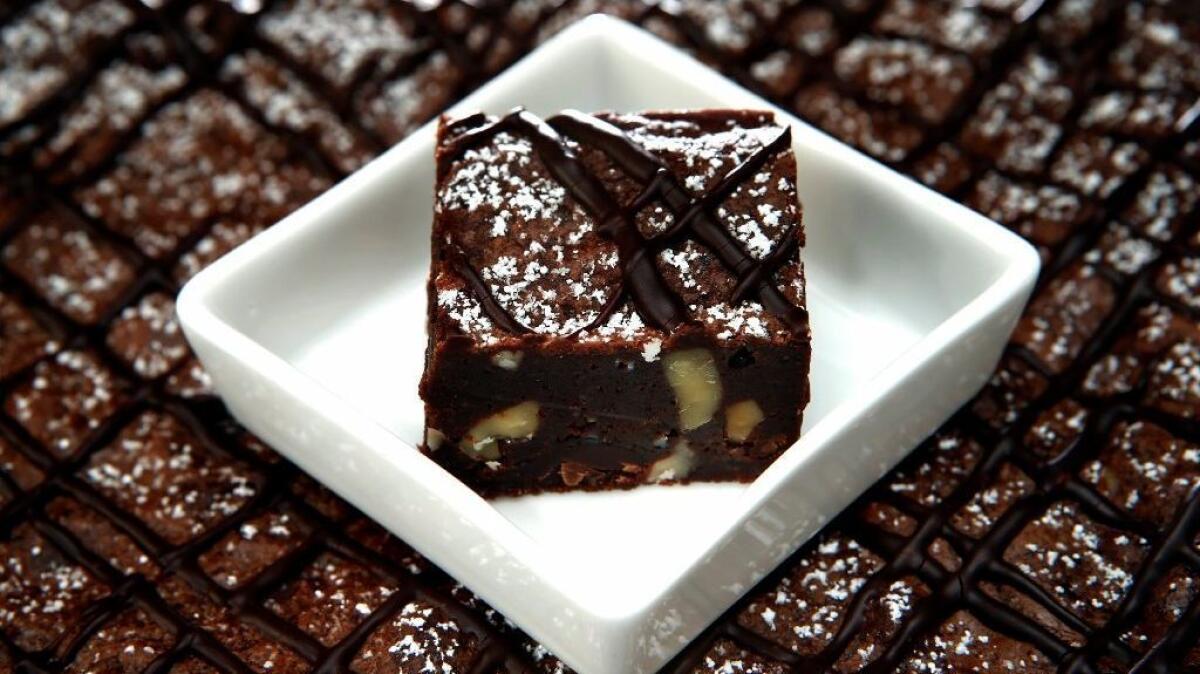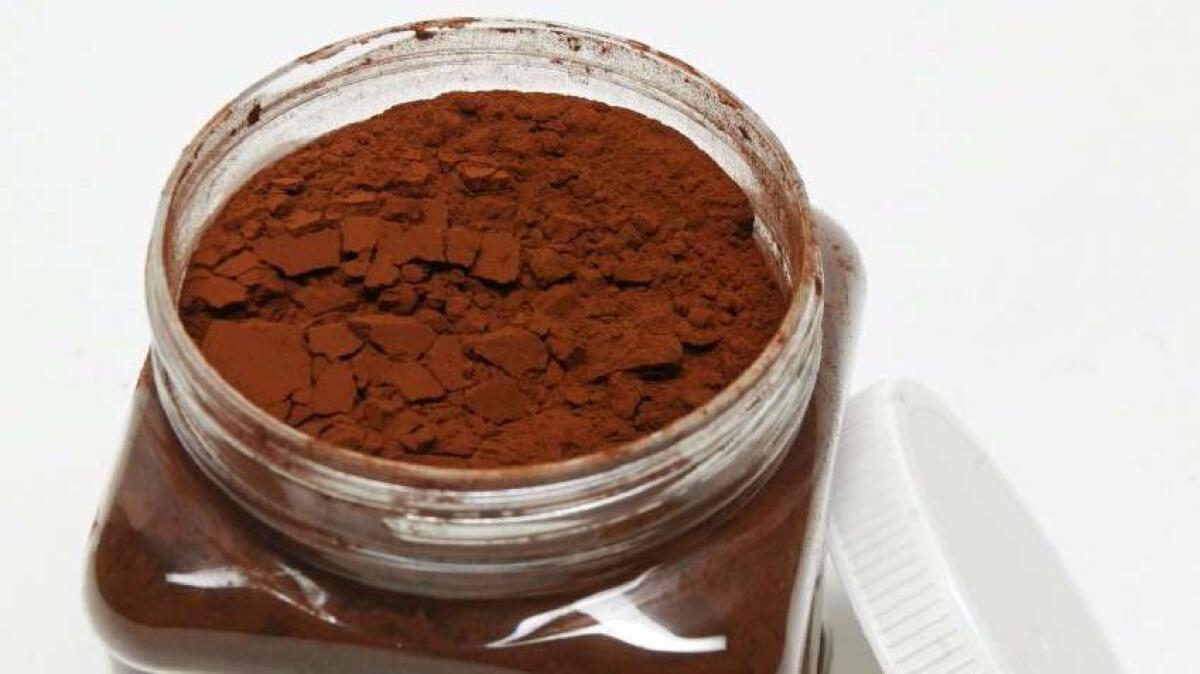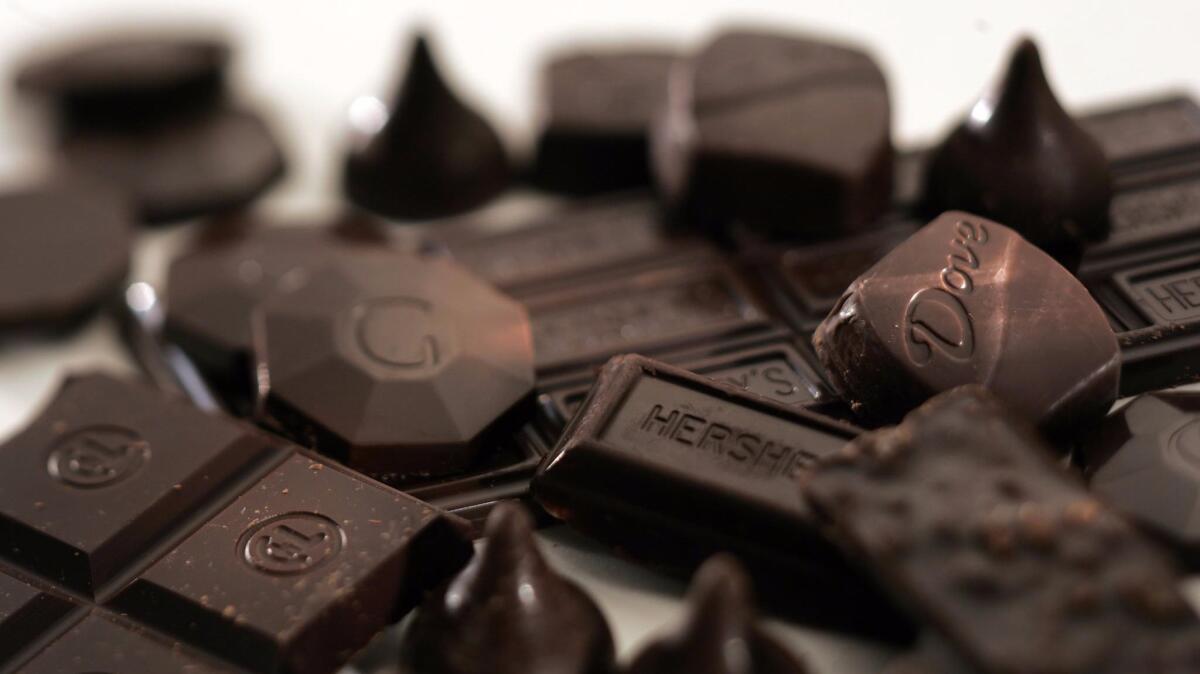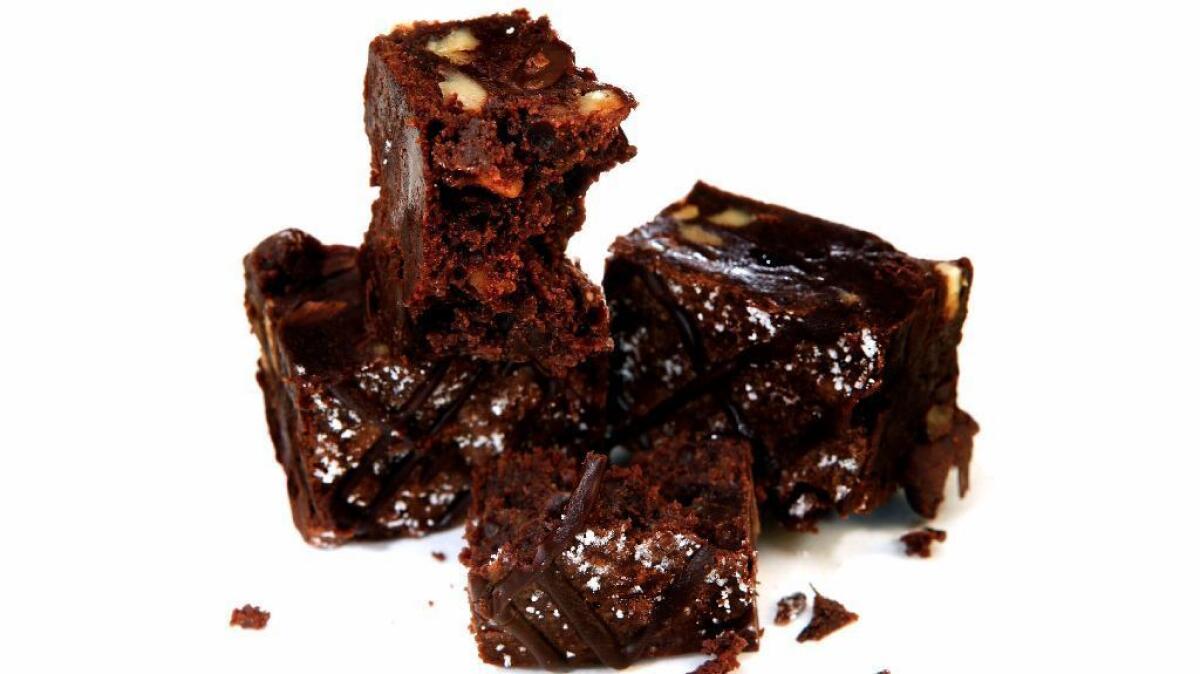How to make the best brownies ever, plus a recipe

There’s nothing like the the sight of a freshly baked batch of brownies. And not just for those of us with a sweet tooth. Most people — well, the fun ones — are brownie fans, which is why we see them everywhere, from potlucks to office parties, birthdays to school lunches. Rich to the hilt and unapologetically messy, a great brownie is savored slowly, with your eyes closed.
And while there may be no such thing as a “bad” brownie, the best ones are truly memorable.
Chocolate, butter, sugar, flour and eggs, mixed together and baked in a pan. Simple as they may appear, there is a definite chemistry behind a great brownie recipe. “When we teach brownies, we always talk about listening and paying attention to the recipe,” says Clemence Gossett, co-owner of the Gourmandise School of Sweets & Savories in Santa Monica. The ratio of each component, the quality of ingredients, and the method by which they are combined and baked can make a good brownie even better.
Over the last few weeks, I tested close to a dozen brownie recipes from a variety of sources both old and new. Some recipes call for chocolate, others use cocoa powder — and still others incorporate both. And while recipes vary in the amounts of butter and sugar they use, one of the biggest variables is flour, with older recipes calling for a larger ratio of flour to other ingredients, making for a more “cake-like” brownie. Newer recipes have reduced flour, some to the point of almost eliminating it, resulting in more fudge-like brownies.
It’s all about the chocolate
For award-winning cookbook author and baker Alice Medrich, it’s all about the chocolate. “Most recipes, if you go back and look at older American cookbooks, it’s all unsweetened chocolate,” says Medrich, a longtime chocolate authority and widely credited with introducing the chocolate truffle to the United States. “That’s what we had in the grocery store when I was growing up. Even if there was a bar of semisweet out there, nobody made brownies out of it.”
Medrich credits much of the brownie evolution to the increased availability of different kinds and percentages of chocolate in the ’90s. And as variety improved, so did the quality of chocolate. Medrich notes that her cookbook, “Bittersweet,” was the first of its kind to discuss chocolate percentages, how to use them, and their effect in recipes. “I wanted to celebrate all those choices,” she says. “Bittersweet” includes several recipes for brownies including some that use unsweetened, bittersweet and semisweet chocolates.
You can never have too much chocolate in a brownie.
— Clemence Gossett, co-owner, the Gourmandise School of Sweets & Savories
While changing the type of chocolate will affect the chemistry of delicate dishes such as a chocolate mousse, brownies are much more forgiving. “It’s going to affect the sweetness of the brownie,” she says. “But brownies are not so finicky that you still won’t get something edible and maybe even delicious.”
When it comes to a chocolate bar versus chips, the two are not interchangeable. Chocolate chips have extra wax added to them so they hold their shape during baking and they won’t make for a smooth and even chocolate if substituted for bar chocolate.
People used to think that cocoa brownies were second-rate because cocoa wasn’t as luxurious or wonderful as chocolate, Medrich notes. But if you have the right recipe, a cocoa brownie can be fantastic, “partly because of the cocoa, and partly because of the drama of the crustiness on top and the gooey center.”
If you use a good cocoa, you can get a stunningly good brownie.
— Alice Medrich, award-winning cookbook author and baker

The differences between natural and Dutch-process cocoa powders:
- “Natural” cocoa powder is typically sold unsweetened, and while it may taste bitter on its own, its natural acidity works with baking soda to help leaven baked goods, giving the finished dish a balanced chocolate flavor.
- Cocoa powder is often treated with alkali to make what is known as Dutch-process or alkalized cocoa. The alkali neutralizes the natural acidity in the powder, giving the cocoa a more mellow and smooth, less bitter flavor. Dutch-process cocoa also has a richer, deeper color than natural cocoa.
If there is leavening in the recipe, the type of cocoa matters (baking soda requires natural cocoa). Otherwise, use any type of cocoa you want. If you make two batches of the same brownie, one using Dutch process and one with a natural cocoa, the Dutch process might look more appealing because it’s darker. The natural will appear lighter and slightly more reddish. “But close your eyes and taste,” says Medrich. “I personally think the one with natural cocoa will have a lot more ‘chocolate’ flavor, but the room may divide.”
Also keep in mind that you can’t just substitute cocoa powder for bar chocolate. Bar chocolate includes cocoa butter and sugar, whereas cocoa powder does not. You’ll find cocoa-based brownie recipes tend to have much more butter and sugar to compensate for this.
Mellowing brownies out with vanilla is not going to give you as deep and rich a cocoa flavor.
— Clemence Gossett
“One other thing I find really helpful is that I never use vanilla extract in my brownies,” says Gossett. “I don’t do that in my cookies either.” All chocolate, except for cocoa powder, contains vanilla, Gossett explains. When you add vanilla extract, you get vanilla in both the batter or dough, as well as the chocolate, which mutes the chocolate flavor. “In brownies, you really want the flavor of chocolate to pop,” she says.
Ratio, ratio, ratio
When you study the ratio of brownies, the less fat there is in the chocolate — the darker the chocolate, or the more cocoa powder — the higher the ratio of fat and sugar in the recipe. I’ve found I prefer using a good quality cocoa for my brownies precisely because I can manipulate the amount of fat and sugar in the recipe. Regular butter melts at a much lower temperature than cocoa butter, found in bar chocolate, which will affect the final texture of the brownies.
“Have you ever made a cookie with a ton of melted chocolate, and even though the cookie is good, it feels kind of dry and hard? That’s the cocoa butter,” says Medrich. “Cocoa butter takes a while to melt and makes it feel like you’re eating something dry and hard and crumbly, even when you know there’s a boatload of chocolate in there.”
Gossett actually prefers to use cultured butter, arguing that the lactic acid in the butter works really well with the chocolate. “There’s that sweet tang that I love,” she says.
The amount and type of sugar will also affect the final texture and flavor of the brownies. “Powdered sugar will make the brownies gummy,” says Gossett, arguing that the cornstarch in the sugar used to prevent it from caking imparts an almost sticky texture.
Granulated sugar, particularly in cocoa-based brownies, gives them almost a candy-like crust and an extra-soft interior.
Gossett prefers standard white granulated sugar for brownies and meringues. “Other sugars get really granular, and you don’t get a smooth texture.”
As for leavening, it depends on the recipe and other ingredients. Gossett doesn’t use any leavening unless she’s making a whole-grain brownie and needs a little lift. Zoe Nathan, co-owner and baker at Huckleberry, Rustic Canyon, Sweet Rose Creamery and Milo & Olive, uses leavening in two of the brownie recipes she rotates at her bakeries.

Flour
Along with chocolate, the biggest evolution in brownie recipes has to do with the ratio of flour. Where brownies were once almost cake-like, many recipes call for just enough flour to bind the other ingredients, resulting in brownies bordering more on fudge. “Back then, everybody pushed that sort of cake [texture],” says Nathan. “That was so fun. Now we go with that decadent bite.”
Additionally, a lot of bakers are experimenting with whole-grain and non-gluten flours. With non-gluten flours, Medrich says the brownies are “more candy-like, not in the chewy way, but in the soft and melt-in-your-mouth kind of way.”
Notes Nathan, “You can make a buckwheat brownie, and a kid will eat it. You can make a rye brownie, and a kid will eat it. You can make a gluten-free brownie, and everyone would eat it.”
The mechanics of brownies
Tips and tricks for taking your brownies to the next level
- Unless you prefer cake-like brownies, undercook them a bit and put them in the fridge to chill a couple hours before slicing, says Nathan.
- Timing is generally more important than temperature when baking brownies. How long they bake is important because overcooked brownies are tough and dry.
- Brownies are typically baked at higher temperatures if they have a topping. The higher temperature does double duty by toasting or coloring the topping as the brownies bake.

Triple-chocolate brownies
View recipe in our California Cookbook »
1 hour, plus chilling and cooling times. Makes about 3 dozen brownies.
1 ½ cups (3 sticks) butter
2 cups (14 ounces) granulated sugar
1 1/3 cups (4 ¼ ounces) cocoa
2 ounces cream cheese, cut into small pieces
4 eggs
½ teaspoon salt
1 cup (4 ¼ ounces) flour
8 ounces chopped bittersweet chocolate, divided
1 1/3 cups coarsely chopped toasted walnuts (optional)
2 tablespoons powdered sugar
¼ cup heavy cream, warmed
1. Line a 13-inch by 9-inch baking pan with foil. Lightly grease the foil.
2. In a heavy-bottom saucepan, combine the butter and sugar over low heat, stirring frequently until the butter is fully melted to form a smooth syrup. Stir in the cocoa and remove from heat.
3. Remove the mixture to a large bowl. Stir in the cream cheese, pressing any bits against the bowl to smooth them out and incorporate into the mixture. Add the eggs, one at a time, until fully combined, then stir in the salt. Add the flour and stir vigorously until the flour is fully incorporated and pulls away from the sides of the bowl.
4. Stir in 6 ounces chopped chocolate, along with the nuts, if using. Spread the mixture into the prepared pan. Cover and refrigerate until well-chilled, preferably overnight, before baking.
5. Heat the oven to 325 degrees and place a rack on the lower third of the oven. Uncover the brownies and bake just until a toothpick inserted in the center comes out slightly moist, 35 to 40 minutes. Remove from heat and cool completely on a rack.
6. Remove the foil-lined brownies from the pan and spread the foil out on all sides to form a border around the brownies (this will keep your countertop clean as you decorate). Lightly cover the cooled brownies with powdered sugar.
7. Over a double boiler, or using a microwave-safe container, melt the remaining 2 ounces chocolate. Stir in the cream to form a ganache. Place the ganache in a piping bag, or a sealable plastic bag with one of the corners snipped off, and drizzle the ganache over the brownies. Cut and serve immediately. The brownies will keep, covered and refrigerated, for up to 1 week.
Each of 36 servings: Calories 189; Protein 2 grams; Carbohydrates 17 grams; Fiber 2 grams; Fat 12 grams; Saturated fat 7 grams; Cholesterol 44 mg; Sugar 13 grams; Sodium 48 mg
Note: From Noelle Carter. To toast the walnuts, spread them out onto a rimmed baking sheet and bake until lightly golden and fragrant, 6 to 8 minutes.
ALSO
Save room for an extra slice: Great cheesecake recipes
Granola, shortbread, brownies and more: 27 great bar recipes
Grilled, marinated and more: Great steak recipes
Your glass of horchata can be a lot more mysterious than you think
Eat your way across L.A.
Get our weekly Tasting Notes newsletter for reviews, news and more.
You may occasionally receive promotional content from the Los Angeles Times.








